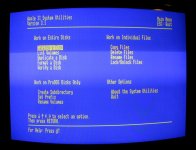Drken
Experienced Member
I know this has been discussed in the past, but I can't seem to find the threads (probably ignorance on my part). I have a board on my IIGS which allows me to connect the IIGS to an LCD monitor. The results are acceptable, but still not very good.
On eBay, there is a seller who is selling a unit (here) advertised as for the IIGS in the ad title, but when you read through the ad text, the IIGS is not mentioned at all... nor is Apple itself. I contacted the seller & asked specifically if they have tested the device with an Apple IIGS and here is the response I received (the same ad appeared with two different titles):
"These two listings function exactly the same. Important requirement to use this product is the source device must be outputting CGA signal at Horizontal 15.73, or, 15.62 KHz + Vertical 60, or, 50 Hz Non-interlace. The same requirement goes for Apple IIGS. Based on the feedback we received, some Apple IIGS user has met the frequency requirement, and some did not. Therefore, please find out about the signal frequency before purchasing."
My question pertains to the last half of the response: Does it make sense that some Apple IIGS units would meet those output specs, and others wouldn't? Would 0.11 KHz difference matter, and what are the chances that there is this much variation in IIGS units?
In refurbishing Apple IIs these past few years, I have seen what, to me, is an extraordinarily high variation within a model. Much of that variation appears to me to be the result of exactly where & when a component was manufactured. One small example: on some Apple IIc cases, the top and back panels are one single, molded piece, whereas in other IIc units, the back plate is a separate piece from the top of the case, held together with several snap-hooks. In another thread here, someone else pointed out several differences in IIe motherboards. Of course, you would expect some differences to crop up over time, much as you would in minor variations in software (eg., v 3.01 vs 3.02). But would there be such variation within an Apple IIGS that such a peripheral as above might work on some IIGS units and not others?
Ken
www.Apple2Online.com
P.S. If ignorance is truly bliss, why am I not supremely happy???
On eBay, there is a seller who is selling a unit (here) advertised as for the IIGS in the ad title, but when you read through the ad text, the IIGS is not mentioned at all... nor is Apple itself. I contacted the seller & asked specifically if they have tested the device with an Apple IIGS and here is the response I received (the same ad appeared with two different titles):
"These two listings function exactly the same. Important requirement to use this product is the source device must be outputting CGA signal at Horizontal 15.73, or, 15.62 KHz + Vertical 60, or, 50 Hz Non-interlace. The same requirement goes for Apple IIGS. Based on the feedback we received, some Apple IIGS user has met the frequency requirement, and some did not. Therefore, please find out about the signal frequency before purchasing."
My question pertains to the last half of the response: Does it make sense that some Apple IIGS units would meet those output specs, and others wouldn't? Would 0.11 KHz difference matter, and what are the chances that there is this much variation in IIGS units?
In refurbishing Apple IIs these past few years, I have seen what, to me, is an extraordinarily high variation within a model. Much of that variation appears to me to be the result of exactly where & when a component was manufactured. One small example: on some Apple IIc cases, the top and back panels are one single, molded piece, whereas in other IIc units, the back plate is a separate piece from the top of the case, held together with several snap-hooks. In another thread here, someone else pointed out several differences in IIe motherboards. Of course, you would expect some differences to crop up over time, much as you would in minor variations in software (eg., v 3.01 vs 3.02). But would there be such variation within an Apple IIGS that such a peripheral as above might work on some IIGS units and not others?
Ken
www.Apple2Online.com
P.S. If ignorance is truly bliss, why am I not supremely happy???


